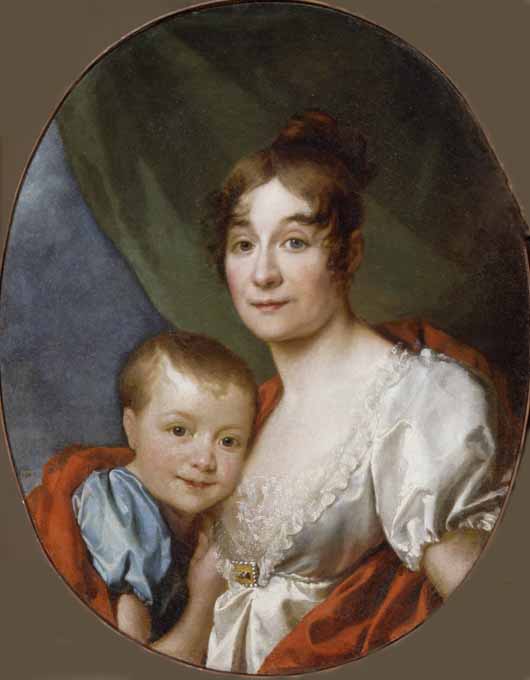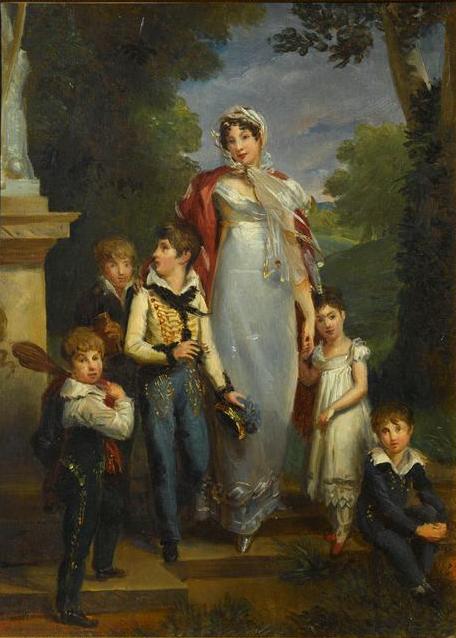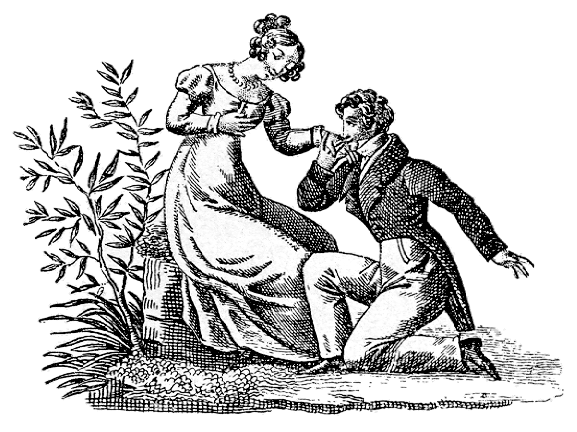Vanessa here, writing with tongue in cheek about Regency transportation.
News of the heroine’s abduction has made its way to the hero. With a quick prayer for strength, he yanks on his tailcoat and readies to chase after the villain and reclaim the lass. How will the hero get to his sweetheart in time? It all depends upon the hero’s fortune and location.
Poor vicar standing in his country parish.
More than likely, he’s going to walk. To keep a carriage for his personal use and maintain his household (a cook and a valet/groom) he’d have to have a living of at least 700 pounds per year above his keep. (Modest household annual expenses cost about 350 pounds.) If the tithe from his parish weren’t enough, maybe his noble patroness would lend him the use of one of her carriages.
Man of good income standing in the drawing room of his country manor.
He’d rush to his steward to send word to his grooms to ready his vehicle in the coach house. The coach house was an independent building kept on the hero’s lands that housed his carriage(s), similar to what a garage does today. There the vehicles could be kept clean and safe from the weather or critters. The hero couldn’t keep the carriage in a stable. Being so near the feed would invite mice. Varmints do bad things to the fabrics of the interiors. It simply wouldn’t do for the hero to arrive in a shabby condition.

American Heritage Dictionary: Carriage in a Coach House.
Man of moderate income living in London.
He’d rush to his groom or valet, whoever was in closer proximity within the few feet of his leased rooms. The hero would instruct his servant to hire a gig (a generic term for any two-wheeled vehicle with seating for two) or a hackney (the “cab” system of Regency London) if the villain kept the heroine within the city. If the villain had fled London, the groom would be sent to the nearest stable or coach house to rent transport. This is not instant and could take hours to arrange.
Man of good income living in London.
He’d rush to his groom or steward, whoever was in the closest proximity within the first level of the hero’s leased town home and follow his man out to the mews in the alley behind the house. The hero’s horse(s) and carriage would be kept there. Mews are similar to the coach houses, just smaller.
So the hero has “called” for his mode of transportation, but what are his options?
Horse: If the hero has a long way to travel and time is of the essence, nothing beats horse back. If the weather is bad with snow on the ground, road travel by carriage would be nearly impossible. The road conditions were poor enough in good weather.
The hero would have no choice but to travel by horse. At a gallop, a horse could average 30 miles per hour, which is faster than the 5 to 7 miles per hour in a carriage. Thoroughbred, Percheron, Belgian, Clydesdale, and Shire breeds were available during the Regency. Hopefully, the heroine wouldn’t mind him on horseback. Maybe she fancies being saved by a knight in Damask waistcoat armor.

Know your Horseflesh
Barouche: This is a large vehicle typically drawn by two horses. The seated occupants face each other. A large hood could fold over the passengers but could be driven open, for every one to see the occupants. Closed, this vehicle was good option for medium distances, 25-50 miles.

The Barouche Carriage
Landau: This is a four-wheeled carriage known for being driven open to show off the occupants. It’s typically drawn by a pair, four-in-hand. The top is soft and folds into two sections exposing the interior. Our hero’s rescue plans may be thwarted in an open carriage, not to mention the dangers of the heroine’s reputation being sullied to the world.

1819 Ackermann’s Repository Landaulet Landau Carriage

Georgiantimes.homestead.net – Know your Landau Parts
Chaise: This is an open carriage with seating for one, two, or even three (if the driver rides one of the horses, postilion style.) Our hero would have to be creative with his rescue plans to use the smaller versions of the chaise. Hopefully, the heroine is alone, no little sister in tow. Thus unusual riding arrangements won’t be needed.

Chaise Illustration by Pearson Scott Foresman
The Post Chaise: This is a four-wheeled closed carriage driven by a team of four. The driver had to ride one of the horses. The post chaise could have windows, even in the front, perfect for searching the landscape. It also had a luggage platform, which could carry supplies or a portmanteau for a change of clothes. If the hero has to travel a far distance, this is the vehicle of choice, and it’s perfect for ferrying a group of servants or secondary characters.

Courtesy of the Suffolk Museum – The Post Chaise

The Rear of the Post Chaise
Coach and Four: This is a four-wheeled closed vehicle drawn by four horses. There is a luggage box in the front. The driver would sit or straddle this depending on the coach design. The back also had a luggage box or basket. The interior hosts hidden compartments for bags of ransom money or a flintlock.
If this is our hero’s lot, he will languish with worry with his head nestled on the Padua silk lining the walls as he drives his fist into the upholstered brocade fabric of the seat backs. Carriage interiors could be contrived with anything the hero or his patroness could afford: silk, tapestries, glass windows, lanterns for lighting, etc. Leather was typically used for open carriages because of the smell arising from the chemicals used in tanning and treating the hides.
Wealthy members of the Ton used the Coach and Four for daily transport. The less wealthy would use these for long distances. If money is of no concern for the hero with his 30,000 pounds per year, this would be in his coach house or mews.
Even if the hero is tight with his coins, for a long journey this would be the hero’s best option.

The Coach and Four with Servants on the Roof
Cocking Cart: This is a two-wheeled open carriage led by one horse. The hero would have to drive this. There is only room for him and the heroine. This is a less expensive option, so a hero of modest means could lease this.

GeorgianTimes.Homestead.net – Cocking Cart
Curricle: This is a two-wheeled open carriage pulled by two horses (preferably well matched so that the carriage doesn’t jerk.) This vehicle is typically controlled by our hero, not a groom, though the hero could have a groom drive. These vehicles are built for speed, but these speeds were no more than 5-10 miles per hour.

The Curricle
Dogcart: This is a two-wheeled or four-wheeled vehicle with back-to-back seating for four. The dogcart is another less expensive option but not very speedy. If the heroine has a best friend or little sister in tow, he may not have the option of enjoying the heroine’s fine eyes if the hero and heroine cannot share the same seat.

The Dogcart
Phaeton: This is an open carriage with four-wheels with one or two seats. A high phaeton as shown below would be so tall, the villain would see our hero coming. Also, some were prone to tipping. Tipping would probably doom the rescue.

The High Phaeton
The hero’s dilemma is great as is his choices for transport. With the exception of the Victoria and the Corbillard, the illustration shows an abundance of carriage choices known to the Regency World.

Illustration from The Dictionary of P. Larousse
Closing Thoughts
Transportation options varied in the Regency from walking to horseback to carriages. As income dictates whether the average Joe can afford a Chevette or Cadillac, it also weighed heavily on all members of Regency society. Plausible cases can be made for any of the hero’s options, but it should be consistent with his status, time frame, geography, and even the weather.
Hopefully, the hero has chosen wisely and is now on his way to save the heroine. Let’s pray he gets there in time.
References:
http://www.pemberley.com/janeinfo/pptopics.html
http://www.rubylane.com/
http://www.susannaives.com/nancyregencyresearcher/
http://main.thebeaumonde.com/
http://www.britannica.com/
http://janeaustensworld.wordpress.com
http://historicalhussies.blogspot.com
http://janeausteninvermont.wordpress.com
Driving horse-drawn carriages for pleasure: the classic illustrated guide to coaching, harnessing, stabling, etc. by Francis T. Underhill
An Economic History of London, 1800-1924 by Michael Ball, David Sunderland.
Originally posted 2012-03-12 10:00:00.








 Probably the most infamous of the taxes was the window tax. It was doubly bad because there was also a Glass Excise tax. So you got taxed when you bought the glass for the window and then taxed for having the window.
Probably the most infamous of the taxes was the window tax. It was doubly bad because there was also a Glass Excise tax. So you got taxed when you bought the glass for the window and then taxed for having the window.






 included a feathered headdress and hoopskirts. This was known as her come out. An average debutante might attend 50 balls, 60 parties, 30 dinners, and 25 breakfasts over the course of a season.
included a feathered headdress and hoopskirts. This was known as her come out. An average debutante might attend 50 balls, 60 parties, 30 dinners, and 25 breakfasts over the course of a season. considered a failure. The season ended officially on August 12, when Parliament adjourned, after which everyone retreated to their country estates.
considered a failure. The season ended officially on August 12, when Parliament adjourned, after which everyone retreated to their country estates.
























